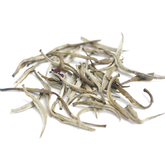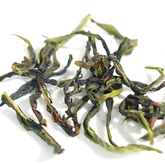Top 3 Chinese Teas for Beginners (Sweet and Smooth)
In our previous beginner’s Chinese tea guides, you've already learned what real tea is , why Chinese loose leaf tea is different from tea bags and received a basic introduction to the six major types of Chinese tea.
Now, you might be facing a common problem all new tea drinkers encounter: when confronted with a dazzling array of Chinese tea names, you might feel confused again. Names like Longjing, Tie Guan Yin , Pu-erh , and BaiMuDan sound quite complex Chinese tea names, even daunting. You might also worry if Chinese tea always requires intricate Gongfu tea tools, like a gaiwan , to achieve a good taste, as seen in Chinese tea houses?
Don't worry! This article is precisely designed to alleviate these concerns. We will highlight 3 types of Chinese tea that are most suitable for beginners abroad for everyday brewing. They are known for being not bitter or astringent, sweet and smooth, and are very easy to brew using your regular mug or glass cup at home.

It’s important to note, however, that not all Chinese teas are suitable for long steeping. For instance, some Oolong teas and Dark teas (Hei Cha) , if steeped for too long in a mug, can very easily become bitter and astringent, impacting the tea's taste profile. But the three Chinese teas we recommend today do not have this issue at all, so you can confidently give them a try.
TOP1-Jasmine Green Tea (Best Chinese Restaurant Tea)
Jasmine tea( not green tea ) is one of the most popular scented teas in China, and it's a tea used in Chinese restaurants very frequently. It's not a flavored tea with artificial additives; rather, it’s made by scenting high-quality green tea leaves with fresh jasmine blossoms using a unique "scenting process" (窨制). The jasmine flowers are repeatedly mixed with the tea leaves, allowing the tea to absorb their exquisite floral aroma, then separated. The result is a Jasmine tea that remains a natural, additive-free loose leaf tea.
(Further Reading: Jasmine Green Tea Benefits And A Complete Introduction )

Why It's Good for Beginners: For new tea drinkers trying Chinese tea for the first time, Jasmine tea is an excellent choice. It's renowned for its fragrant floral aroma and clean, sweet taste, with almost no bitterness or astringency. Even if you accidentally steep it for too long in a mug or glass cup, it won't easily turn unpleasant. Its pleasant aromaand smooth drinking experience make it very easy for everyone to accept and love, making it an ideal Chinese loose leaf tea for daily enjoyment.
Daily Mug Brewing Tips:
- Dosage: Add Jasmine tea leaves to the bottom of your mug or glass cup (usually about 3-5 grams of loose leaf tea).
- Water Temperature: After boiling water, let it cool slightly (around 85-90°C). Brewing with slightly lower water temperature will better preserve the delicate floral aroma of Jasmine tea.
- Steeping: Pour hot water directly into the cup and wait for about 1-2 minutes before drinking. High-quality Jasmine tea can be re-steeped 2-3 times after the first infusion; you can extend the steeping time slightly for subsequent infusions and still enjoy its sweet and fragrant notes.(Further Reading:How Long To Steep Jasmine Tea)
Recommended Purchase:Jasmine Green Tea— XueZhu /Jasmine Green Tea— MoLv
TOP2-White Tea (Bai Mudan / Yueguang Bai): Soft and Elegant Sweetness
White tea is one of the six major types of Chinese tea with the least processing, renowned for its most natural and pure quality. In the White tea family, Fujian Baihao Yinzhen (Silver Needle) is the top-tier representative, made exclusively from the most tender tea buds. Fujian Bai Mudan (White Peony), on the other hand, consists of one bud and two leaves. Yueguang Bai (Moonlight White) is a captivating White tea from Yunnan province, known for its very charming aroma.

Why It's Good for Beginners: For beginners exploring Chinese tea, White tea is another extremely friendly option. It possesses a unique natural sweetness and a gentle, soft mouthfeel, with almost no bitterness or astringency, making it ideal for daily drinking. Unlike other tea types that are very sensitive to steeping time, White tea is highly forgiving; even if steeped a bit longer in a mug or glass cup, its flavor profile remains mellow and smooth, without developing an unpleasant bitterness. High-quality aged White tea can even be boiled, making it particularly suitable for winter enjoyment.
Daily Mug Brewing Tips:
- Dosage: Add about 4-6 grams of White tea to your mug or glass cup.
- Water Temperature: White tea can be brewed directly with boiling water (100°C), as high temperatures help release its unique sweetness.
- Steeping: For the first infusion, we recommend waiting about 3-5 minutes to allow the tea leaves to fully unfurl. For subsequent infusions, you can extend the steeping time according to your personal preference. White tea is very robust for multiple infusions and can be re-steeped many times.
Recommended Purchase:Chinese White Tea- Moonlight Beauty
TOP3-Green Tea (Xihu Longjing, Bi Luo Chun): Clean, Fresh and Sweet
Green tea is one of the six major types of Chinese tea that undergoes the least processing and has the lowest oxidation level. After harvesting, the tea leaves are quickly heated—either by steaming or pan-firing (known as "sha qing" or "kill-green")—to immediately stop oxidation. This process maximizes the preservation of the tea's freshness, its natural vibrant green color, and abundant nutrients. Longjing tea (Dragon Well), as one of China's most famous green teas, is beloved for its unique flat appearance and clean, fresh aroma.(Further Reading: Complete Introduction to Chinese Green Tea and the Best Green Teas )

Why It's Good for Beginners: For Chinese tea beginners, choosing a high-quality green tea (especially Longjing or Bi Luo Chun) is also an excellent starting point. It's known for its fresh, clean, and often vegetal aroma, sometimes with a nutty undertone or a hint of sweetness. More importantly, premium green tea is typically not bitter or astringent; its clean and refreshing taste is very easily accepted by those new to Chinese tea. It’s easy to brew and highly suitable for daily consumption.
Daily Mug Brewing Tips:
- Dosage: Add about 3-5 grams of loose leaf Longjing green tea to your mug or glass cup.
- Water Temperature: Green tea is quite sensitive to water temperature. We recommend letting the boiling water cool for a few minutes (ideally around 80°C) before brewing. Water that is too hot can make green tea slightly bitter.
- Steeping: Pour hot water directly into the cup. For the first infusion, steep for about 1 minute before drinking. For subsequent infusions, you can extend the steeping time slightly based on your preferred strength. High-quality green tea can usually be brewed 3-4 times.
Conclusion & What's Next
Congratulations! Through this article, you’ve not only learned about three sweet and smooth loose leaf Chinese teas that are most suitable for beginners—Jasmine tea, White tea (Bai Mudan/Yueguang Bai/Baihao Yinzhen), and Green tea (Xihu Longjing/Bi Luo Chun)—but more importantly, you've overcome concerns about the complexity and bitterness often associated with Chinese tea.

We've shown that even without specialized Gongfu tea tools, simply using your everyday mug or glass cup, you can effortlessly brew Chinese tea that is not bitter or astringent and has an excellent flavor profile.
New tea drinkers can easily get started with Chinese tea through these accessible varieties. For other tea types like Oolong tea and dark tea, we generally recommend using Gongfu tea tools for brewing. To that end, in our next article, we will delve deeper into ‘ Essential Chinese Teaware for Every Beginner ’ , providing you with the correct loose leaf tea brewing methods for your daily enjoyment.





